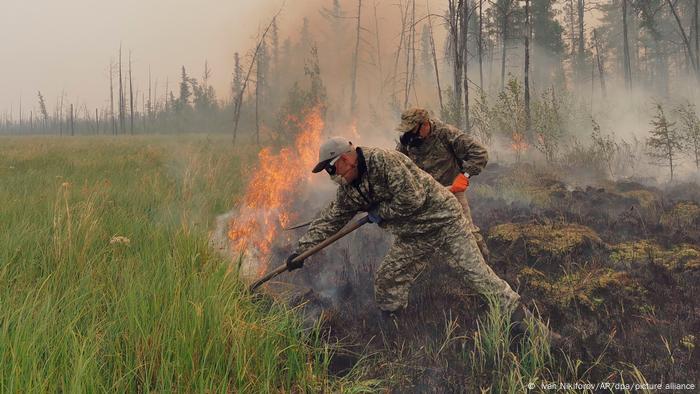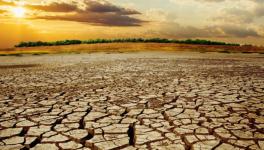Wildfires to Increase up to 30% by 2050, Experts Warn
The Argentine government estimates recent fires have caused some $184 million (€162 million) in economic damage
Exhausted firefighters have been battling blazes in northern Argentina for weeks. Fueled by strong winds, little rain and dry conditions brought on by an unusually long drought, wildfires have already destroyed nearly 8,000 square kilometers (3,000 square miles) of forest, swamp and farmland, an area slightly smaller than the island of Puerto Rico.
"It never happened to us, we never lived something like this, we were really overcome," one resident, Jorge Ayala, told The Associated Press news agency over the weekend. But wildfires like this are expected to become more prevalent, and more destructive, in the coming years and decades.
Extreme fires — more frequent, intense and increasingly found in atypical areas like the Arctic — are projected to rise up to 14% by 2030 and 30% by mid-century, according to a new report by the UN Environment Programme (UNEP) and Norwegian environmental nonprofit GRID-Arendal.
By 2100, they say, fires could be as much as 50% more likely to occur. Even if we manage to significantly reduce emissions, the world is likely to see an increase in wildfires, the report said.
Researchers have increasingly linked these disasters to human-caused climate change, a fact underscored by the report, which links the growing severity of fires to a higher incidence of drought, rising temperatures and strong winds.
"At the same time, climate change is made worse by wildfires, mostly by ravaging sensitive and carbon-rich ecosystems like peatlands and rainforests," said the authors of the report. As these ecosystems are destroyed, they release stored CO2 emissions into the atmosphere, further contributing to global warming and reducing their potential to capture future emissions. "This turns landscapes into tinderboxes, making it harder to halt rising temperatures," they said.
Fires 'disproportionately affect world's poorest nations'
This dire prediction has already started to become a reality. The past few years have seen increasingly destructive fire seasons in places like North America, Brazil, parts of Europe, Siberia and Australia, which have devastated ecosystems and communities around the world.
That destruction — to crops and homes, human health and the natural environment — means wildfires "disproportionately affect the world's poorest nations," according to the report. The fallout can linger for years after fires have been extinguished, especially in parts of the world that lack the resources to rebuild and adapt to the changing environment.
Even regions previously unaffected by wildfires, including Siberia in the Arctic, are now at risk
"Fire impacts air, soil and water," said Glynis Humphrey of the University of Cape Town, who contributed to the report. "Fire interacts closely with the climate, in terms of carbon emissions and rainfall patterns, and it impacts human and ecosystem health. And it impacts people's jobs and the economic situation that people find themselves in."
Focus needs to be on planning and prevention, not response
And yet, experts warned, most global government spending when it comes to wildfires is devoted to fighting blazes after they break out, with less than 1% going to planning, prevention and preparedness. To confront this increasing risk and to lessen the impact of destructive fires, governments will need to "radically shift their investments."
"Current government responses to wildfires are often putting money in the wrong place," said Inger Andersen, executive director of UNEP. "We have to minimize the risk of extreme wildfires by being better prepared: invest more in fire risk reduction, work with local communities, and strengthen global commitment to fight climate change."
The report calls on governments to divert two-thirds of funding to planning, prevention, preparedness and recovery. "It's integral that fire be in the same category as disaster management [for] floods and droughts," said Humphrey, speaking at a media briefing. "It's absolutely essential."
Reintroduction of Indigenous knowledge key
While some of that funding should go toward improved monitoring and analysis, to better understand how wildfires are evolving in a changing climate and what can be done to manage that, the authors also highlight the importance of Indigenous knowledge.
This can include the use of prescribed burns, or "good fires," to reduce fuel that can feed larger blazes. Other methods include creating fire breaks or using controlled blazes to establish mosaic landscapes, which inhibit the spread of wildfires, or promoting the growth of grass and plants that help ward off drought.
"As countries develop and as economies develop and demographics change, a lot of those traditional practices either wither or change or reduce over time, or [are replaced by] alternative land practices," said Peter Moore, who worked as a fire management specialist at the UN's Food and Agriculture Organization.
In response to a DW question, Moore pointed out that Indigenous practices were starting to be recognized and implemented in Australia, Canada and the western US, with organizations such as the International Savanna Fire Management Initiative transplanting traditional Indigenous practices from Australia to places like Botswana.
He stressed that documentation, and having that knowledge made widely accessible, is key to convincing people of the value of these traditional practices — "being able to map [Indigenous] experience, being able to work with it and reintroduce it back into the landscape."
Edited by: Tamsin Walker
Get the latest reports & analysis with people's perspective on Protests, movements & deep analytical videos, discussions of the current affairs in your Telegram app. Subscribe to NewsClick's Telegram channel & get Real-Time updates on stories, as they get published on our website.
















